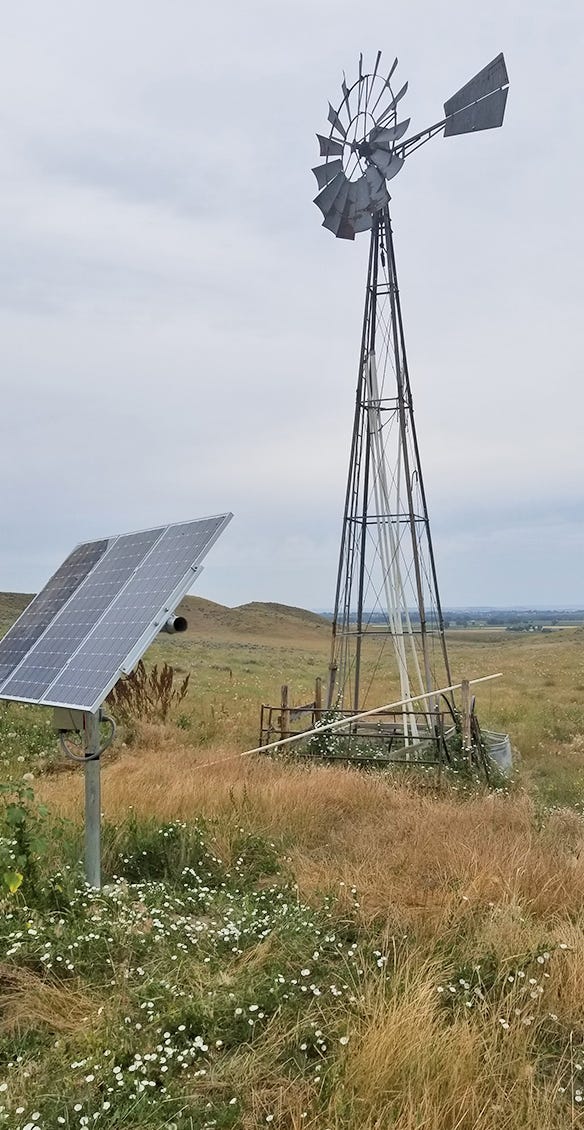July 31, 2018

Old windmills dot thousands of ranches across windy areas of the West, but many ranchers are finding that solar-powered wells are a lot more reliable and require far less maintenance.
These two factors, coupled with new advances in solar technology and falling prices for equipment such as solar panels, have many ranchers looking to the sun in an effort to improve grazing management, bolster profits and make their operations more sustainable.

IN WITH THE NEW: Replacing an old windmill with a solar-powered well boosts water flows, on average, from 3 to 12 gallons per minute. The increased water flow allows cattle producers Scott and Durene Green to run 110 cow-calf pairs in this southeast Montana pasture instead of 26.

“We’re in the process of replacing a windmill with a solar pump because the windmill just wasn’t reliable enough. It was only producing about 3 gallons a minute, and that simply wasn’t enough for the number of cattle we run,” says Scott Green, who ranches in southeast Montana.
“We were underutilizing our pastures,” Green adds. “In this particular pasture, which we use for late-fall, winter and early-spring grazing, we typically have enough grass to run 110 pairs in an intensive grazing rotation; but we have only been able to run 26 pairs because of lack of water.”
The windmill, on average, was only producing 2 to 3 gallons a minute, but the new solar-powered well is expected to pull up to 12 gpm, allowing Green to not only run more cow-calf pairs in that pasture, but also have better control over grazing management.
Though his ranchlands are located in an area that gets wind, he says, “The hours of sunshine are more reliable than the hours of wind.”
With the increased water output, Green is installing a series of stock tanks below the well that will give cow-calf pairs at least two days of water when the skies go dark.
Tracking stock tanks
When cattle are in the pasture, he installs a camera at the well that takes pictures of the stock tanks at 6 a.m. and 6 p.m., and those photos are downloaded to his smartphone.
“I can remotely monitor the water levels, so there are no worries,” he says. “If water is getting low — which I don’t expect to happen with the new solar-powered well — I can load a water tank into the back of my pickup and head to the pasture.”
He adds: “I had to go down there a lot with the windmill, and that’s another reason why we’re converting to solar.”
Fewer trips to the pasture will help boost the bottom line, as each jaunt is a one-hour roundtrip in a four-wheel-drive vehicle loaded with water.
Green contracted with Philip Botch, owner of Arrow Creek Excavation and Irrigation, to help with the solar well and panel installation and other aspects of the project.
“I’m starting to see a lot of solar systems replacing windmills in our area. Ranchers are finding that solar is more dependable; plus, windmills are high-maintenance, just like keeping a vehicle running since there are moving parts,” Botch says.
The system that Botch is installing can accommodate a portable generator in the event of heavy cloud cover for multiple days, which doesn’t often happen in Montana’s Big Sky Country. “With a generator, a guy is not dead in the water while waiting for sun,” he notes.
Botch’s work takes him across hundreds of miles of ranch country in Montana, and solar-powered stock tanks are becoming more common.
“You still see a few windmills here and there, but not very many. Most of them are getting retrofitted with solar units, especially in areas where running an electrical line is cost-prohibitive,” he says. “Hands down, the most practical thing is solar power.”
Waggener writes from Laramie, Wyo.
About the Author(s)
You May Also Like




